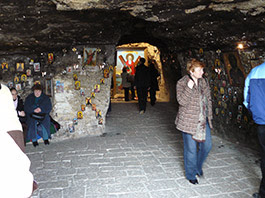
Saint Andrew the Apostle is credited with bringing Christianity to the Dacian (ancestors of modern Romanians) pagans and is considered the nations patron saint. His cave is located in Constanta, the oldest diocese of Romania.
Few things are known about the cave of Saint Andrew the Apostle. One of those things that can be said with certainty is that it was discovered in 1918 by Jean Dinu, a lawyer. After being revealed in his dreamed the location of this lost cave, he came to this area to find the cave in an advanced state of degradation. After cleaning it of the vegetation inside, he built a couple of cells and the first monks came in a short time.
It was sanctified in 1943 by Bishop Chesarie Paunescu, but during the communist period it was destroyed and turned into a shelter for animals.
Only in 1990, with the blessing of IPS Lucian, Father Nicodim Dinca, the abbot of Sihastria Monastery, along with the Hieromonk Father Victorin Ghindaoanu, started to restore the cave and to build the monastery.

The cave shelters the icon of Saint Andrew, known as the apostle who christianized the lands to the North of the Danube. There is a bed carved in stone in a niche of the pronaos. It is said that it was used as a resting place by Andrew the Apostle. In the course of time this has been a place to light candles, and now it is used by those in need of comfort from disease. Here, the priests also read prayers for sick people and the Liturgy of Saint Basil the Great.
Today the monastery has a smaller church built during the years of 1994 – 1995, dedicated to the Holy Virgin’s Protection (October 1), and the third biggest church was built during the years of 1998 – 2002.
In the small church are kept the relics of Saint Andrew. A cross in the shape of “X” can be found, on the left, in front of the altar of the smaller church. In the center of this cross is placed a part of the finger belonging to Saint Andrew. The finger was brought from the Trifiliei Metropolitan Church of Greece. On the four extremities of the cross there are the relics of the martyr saints of Niculitel from Dobrogea: Zoticos, Attalos, Kamasis and Philippos, Epictet the priest and Astion the monk.
Near the cave there is a spring about which the legend tells that it appeared after Saint Andrew struck the rock with his staff in search of water.
Tens of thousands of pilgrims come each year to the Cave of Saint Andrew and this made this place to be rightfully named the Bethlehem of the Romanian people.
To get here, the pilgrims must first reach Cernavoda, afterwards head south to Ostrov. In the locality Ion Corvin, an indicator points them to a side road that takes them to the monastery in a forest, after 3 – 4 km.











